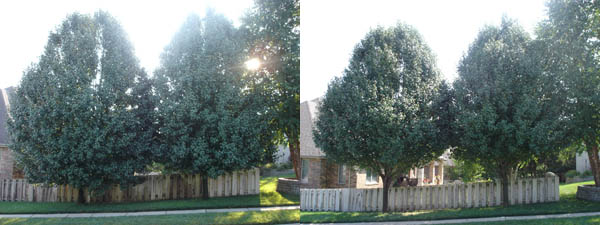Today’s urban landscape trees are some of the most valued and viewed trees growing. Unfortunately, many times we ask them to grow in environments more harsh than their forest growing counterparts. In many cases this causes poor vigor, slow growth, weakened disease resistance, and in general, less than optimal overall health.
So what can a concerned homeowner do to improve the vigor, health, and growth of their tree? A good start is to create a healthy growing environment for the root system. A trees roots bring water and nutrients to the tree. A stressed out root system will result in a stressed out tree. Compacted soil, too much or too little water, competing ground plants, and poor soil quality can all contribute to an unhealthy root system.
Soil compaction is often an effect of construction damage to a tree, from driving heavy equipment over the roots, or placing heavy piles of materials on the roots. Other causes include excessive foot traffic and parking vehicles or equipment under the canopy. Compacted soil will not allow the roots to breathe properly, and will impair the uptake of water and nutrients to the tree. To prevent compaction, especially in high traffic areas or construction zones, some sort of physical barrier should be placed around the tree. The more area encircled, the more root zone protected. Optimally, the rootzone should be protected at least to the dripline. (Picture the shaded ground in noontime sun. The shaded area is the critical rootzone, and the outside edge is the dripline.) Once soil compaction has happened, correcting the problem is more difficult than prevention would have been. The only quick fix to decompact soil without root damage is the use of an air spade. This tool allows the soil to be decompacted with a high pressure spray of air.
Planting a tree in a spot which will suit its needs is abolutely necessary in order for the tree to thrive. If it is planted in a spot which is too dry, additional watering may be all that is necessary. It’s much more difficult to dry out a tree planted in too wet an area. Too much or too little water is a problem which is best avoided through forethought and planning, with careful consideration of the characteristics of the planting location, and the needs of the species being planted.
Many landscape trees are surrounded by lawn. This fact creates several different problems for these trees. First, the area around the trunk is usually mowed or weedeaten regularly. This leaves them suseptible to damage to the trunk or surface roots from metal mower decks or trimmer line or blades. These types of wounds can allow bacterial or fungal infection, and cause the tree to use rescources to heal the wound. Next, all of that lush growing grass draws water and nutrients from the soil, competing with the tree for rescources. Keeping that grass mowed adds to the soil compaction issues. The good news is that all of these issues can be solved with one simple solution. Mulch the critical rootzone of your trees. Trees growing in the forest mulch themselves each year when they drop their leaves. This natural mulch keeps competing ground plants out, and helps keep the soil moist, and retain moisture longer. Yard trees need this mulch to optimize their health. Wood chips are very effective, but they should be aged at least a year after they are chipped before being applied as mulch. Whatever mulch you use should be kept back from the trunk of the tree 6“-12”, to prevent any moisture or rot from damaging the base of the trunk. Your mulch ring should be 2 to 4 inches deep, and extend out to the dripline if possible. As the mulch breaks down, it adds nutrients to the soil. Over time poor quality soil can slowly be improved. Too many trees I observe were mulched in the “Volcano” fashion. Thats where a tall narrow cone of mulch is placed all around the trunk of the tree. This method of mulching does more harm than good, and should never be used. It causes above ground root growth, promotes trunk rot, and provides few of the benefits to the root system of a mulching job done right.
From every angle, protecting the soil from compaction and mulching the critical rootzone to eliminate competing plants, keep mower and trimmer damage away from the trunk and surface roots, conserve moisture, and add nutrients to the soil will help your trees to be healthy and beautiful.
Contact Tree Solutions at 860-0436 if you would like fresh wood chips dropped off at your property for free. We’d also love to hear from you for any and all tree care needs.
Dean Hudson,
Tree Solutions owner.

